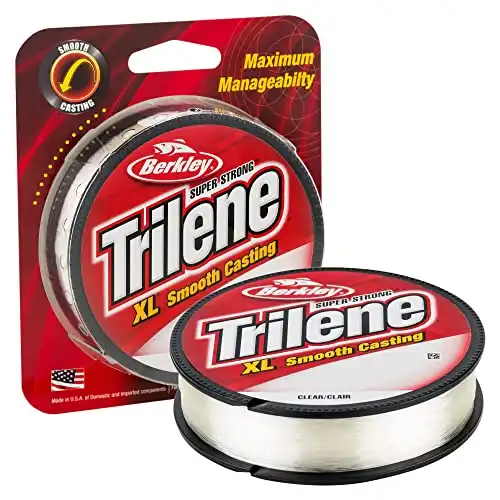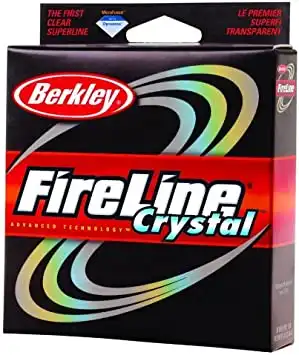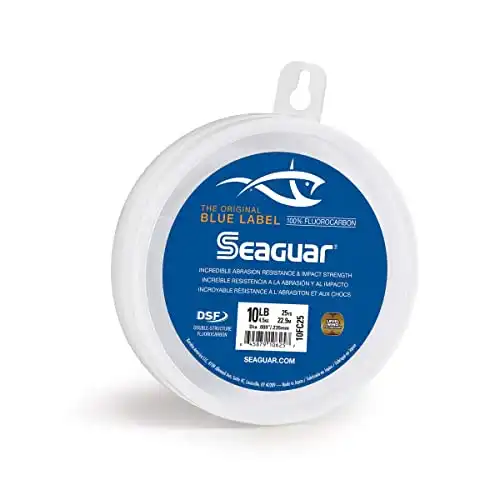
There are few things fishermen enjoy more—other than catching fish—than debating about their favorite baits, lures, lines rods and reels. And one of the most popular debate topics is often which type of line is best; braid, monofilament or fluorocarbon.
Spoiler alert: the answer depends on the situation. Each type of line has its pros and cons, and each will serve you best under a certain set of circumstances.
A lot of anglers keep a rod spooled with each type of line handy at all times, because you just never know which you will need. Whether you’re fishing for bass or catfish, salmon or sunfish, it’s always important to have the right line for the job. Let’s compare braid vs mono vs fluorocarbon, so you can make the best call about which to spool your reel with on your next fishing trip.
Monofilament Fishing Line
As its name implies, monofilament (mono) line is made of a single strand of synthetic material. These days, it’s almost always nylon, but there are a lot of different types of nylon made of various polymers.
Different line manufacturers may ultimately create monofilament line using a wide range of nylon polymers, resulting in an equally wide range in quality and tensile strength. When it comes to mono, you can truly say that you get what you pay for.
The main selling points of mono are its low visibility and its ability to stretch, which helps absorb the impact of a hard-fighting fish. Mono also has a high strength-to-weight ratio (at least, good quality mono does) and it’s naturally buoyant, making it ideal for fishing topwater lures.
Mono is the most popular fishing line in the United States, accounting for about two-thirds of all the fishing line sold in American stores. One of the main reasons for that is that it’s also the most affordable.
Pros of Mono:
- Color: Monofilament is naturally transparent, and can also be dyed blue, green or other colors to blend in with the water in which you’re fishing. That low visibility is one of its greatest assets (it can also be dyed high-vis colors, so you can see it better).
- Buoyancy: Nylon monofilament fishing line has near-neutral buoyancy in water, which makes it good for fishing on or close to the surface.
- Price: The relatively low cost of monofilament line makes it ideal for casual anglers and beginners. Even higher-quality mono is generally cheaper than braid or fluorocarbon (and it is best to go with higher-quality mono).
- Knot tying: Another great benefit of monofilament lines are their knot strength. It’s easy to tie a knot securely, and you can generally fish with confidence that your knots will not fail.
- Stretch: Mono can stretch and flex, allowing it to absorb the shock of a sudden strike or a hard-fighting fish without breaking.
- Abrasion resistance: If you’re comparing braid vs mono, then mono is the clear winner when it comes to abrasion resistance (though fluorocarbon is best of all).
- Easy to work with: Monofilament lines are easy to spool onto your line, easy to tie knots with, and easy to fish with.
Cons of Mono:
- Less sensitivity: Monofilament line’s ability to stretch is a bit of a double-edged sword. Because of its ability to stretch so far, it’s also a bit less sensitive than other types of fishing line.
- Absorbs water: Over time and with constant use, mono absorbs water, which can gradually weaken it. It’s usually best to replace monofilament line on your reels every year.
- UV sensitive: Sun exposure also takes a toll on monofilament line, weakening it over time.
When to Use Mono Line
Because of its buoyancy and low visibility, monofilament fishing lines are popular for bass fishermen using lures like topwater plugs, poppers, spinnerbaits, floating frogs, and chatterbaits that are meant to be fished on or near the surface. It’s also good for any scenario that involves a bobber or float.
The abrasion-resistance of mono also makes it good for fishing around rocks and woody cover in relatively shallow water. It’s also the line of choice for most fishermen who go after a smaller game like panfish, or fish like trout that might be spooked by a highly visible braided fishing line.
When Not to Use Mono Line
Mono can be challenging when you need to get your lure to the bottom quickly, and it’s not ideal for bottom rigs like drop-shotting or Texas/Carolina-rigged soft plastics. It’s also not the best for fishing in thick weeds. For that, a braided fishing line works better, as we shall soon see.
Our Pick For the Best Mono Line
The Trilene XL is an especially thin monofilament line that makes long casts smooth and easy to attain.
Braided Fishing Line
Braided fishing lines are actually some of the oldest lines around. In past centuries, braid was made of natural materials like linen, silk, cotton—even horse hair. These days, it’s commonly made of braided synthetic fibers like Nylon; or in the case of more high-end specialty lines, Dacron.
Because it is made of multiple strands wound together, braid is much stronger than mono, which makes it much thinner. For example, 10-pound-test braided line is typically 1/2 or even 1/4 the thickness of comparable 10-pound mono. This makes it possible to fit more line on your reel, or to use a higher test line without it being unmanageably thick.
Braided line also sinks much more quickly than monofilament fishing line, making it perfect for fishing at greater depths. In addition to its comparably high tensile strength, braid is also more resistant to line twists, and at lighter pound tests offers longer, smoother casting.
Braid does not stretch like mono, which can be a blessing and a curse depending on the situation. It is more vulnerable to abrasion, however, and is generally much easier for fish to see.
Pros of Braid
- High tensile strength: In a matchup between braid vs mono, braid comes out far ahead when it comes to strength. That makes it the line of choice for many big game fishermen.
- Thinner diameter: Braid’s high tensile strength makes it possible to use much thinner line without having to worry about breakage.
- Sensitivity: Because braid does not stretch, it’s possible to feel everything that’s happening at the end of your line with much greater sensitivity.
- Snag resistance: Braided fishing line has enhanced lubricity compared to mono, allowing it to glide through snags more easily. It also has the strength to cut through dense vegetation, which can often save you from losing fish in the weeds.
- UV and water resistance: Braid does not absorb water like mono does, nor is it highly susceptible to UV damage.
- Low memory: Fishing “memory” is what happens when line sits on a reel for a long time, and starts to retain the curve of the spool. It can lead to line twist and birds’ nests of tangled line. This is much less an issue with braid than with mono.
Cons of Braid
- Visibility: Braided fishing line can be dyed various colors, but it is never clear. This can make it easier for fish to see. It’s not ideal for very clear water.
- Initial cost: Braided line tends to cost about 50% more than monofilament (though it does last longer, which offsets this cost).
- Abrasion: Abrasion resistance is braided line’s Achilles heel. Braid often starts to fray when it scrapes up against rocks or other hard objects, which can greatly compromise the integrity of the line.
- Knot tying: The lubricity of braided fishing line, while great for casting and avoiding line twist, can make tying secure knots a challenge. Knots may come undone if not tied correctly, and some anglers use special knots that have been created specifically for braid.
When to Use Braided Line
Because it sinks, braided fishing line excels at fishing in deep water. It is favored by anglers who use lures like jig-head swimbaits and deep-diving crankbaits. It’s also great for bass fishing in thick, weedy cover. Braid is also a great choice any time you’re fishing in murky water and you’re not too concerned about fish seeing your line. In general, braid tends to be preferred by more advanced anglers compared to mono.
When Not to Use Braided Fishing Line
Braided lines can make fishing with surface lures very challenging, so they should not be used for topwaters or floating lures. It’s also best to avoid fishing in rocky habitats with braided fishing lines. Many anglers who need to fish around deep rocks will use braid as their mainline, and then add a leader made of more abrasion-resistant monofilament or fluorocarbon line.
Our Pick For The Best Braided Line
Innovation is the reason FireLine Crystal is the most highly rated braided line in consumer reviews. FireLine is the first translucent braided line on the market.
Fluorocarbon Line
The first fluorocarbon line came out in the 1970s, making it a relative newcomer in the fishing world. While it is not as commonly used as either mono or braid, fluorocarbon is beloved by a lot of professional anglers. In many ways, it offers the best of both worlds, including many of the advantages of mono and braid with few of the drawbacks.
Fluorocarbon line is made of polyvinylidene difluoride (PVDF), a synthetic material that is denser and more abrasion resistant than Nylon. As a result, it sinks much like braided line, but is more resistant to abrasion than a braided fishing line or mono. This makes it especially popular for tying leaders.
With a nearly identical refractive index to water, fluorocarbon line is virtually invisible. It’s stronger than mono (but not as strong as braid) and is resistant to UV damage and water absorption.
The amount of “stretch” in fluorocarbon line is intermediate between mono and braid. It is somewhat stiffer than mono, which isn’t a bad thing, but something to be aware of. That can make it challenging to work with at first. Tying solid knots is a little more challenging with fluorocarbon; it’s important to wet the knot before cinching it tight.
Pros of Fluorocarbon
- Visibility: Fluorocarbon blends in perfectly with water, making it practically invisible to fish.
- Moderate stretch. Fluorocarbon offers just enough stretch to cushion a hard hook-set. It’s not as stretchy as mono, but more so than braid. Consequently, the level of sensitivity is also intermediate.
- Tensile strength: Compared to monofilament, fluorocarbon has higher tensile strength. As a result, it has a thinner diameter, and you can fit more of it on your reel. It’s still not quite as tough as braid, but it’s a good compromise between the two.
- Density: The density of fluorocarbon can be a good thing or a bad thing, depending on your presentation. If you’re fishing near the bottom in deep water, the fact that it sinks is a definite advantage.
- Doesn’t deteriorate: Fluorocarbon resists damage from water, UV rays, chemicals and even salt, the latter of which makes it a very good option for saltwater fishing.
- Abrasion resistant: Fluorocarbon lines have greater abrasion resistance than mono or braid, making them the best choice for fishing around rocks.
Cons of Fluorocarbon
- Stiffness: Fluorocarbon is stiffer than mono, which can make it somewhat cumbersome to use. For this reason, some anglers only use it as a leader rather than a main line.
- Knot tying: Tying secure knots is a bit more challenging with fluorocarbon than with monofilament. Be sure to wet your line when tying a knot.
- Cost: The cost of fluorocarbon line can be significantly higher than monofilament, and is typically on par with high quality braided fishing line.
When to Use Fluorocarbon Line
Fluorocarbon is arguably the most versatile fishing line, with a level of strength and ability to stretch that fall in-between mono and braid. This makes it ideal for getting the most action out of lures like crankbaits, jerkbaits, swimbaits, and jigs. It’s also practically impossible for fish to see, making it the perfect line for clear water.
When Not to Use Fluorocarbon Line
There are very few situations in which fluorocarbon line is not ideal. Because it sinks, it’s best not to use it for topwater lures, but it’s a great choice for just about any other situation.
Our Pick For The Best Fluorocarbon Line
The line is created by combining two resins that combine into a dual structured fluorocarbon. That means it’s got great strength, high abrasion resistance, low visibility and will sink your bait fast.
We hope this post has helped you understand the difference between braid vs mono vs fluorocarbon.
For a great video covering this topic, watch this one below-
For our complete lists of best fishing lines, check out the pages below.




